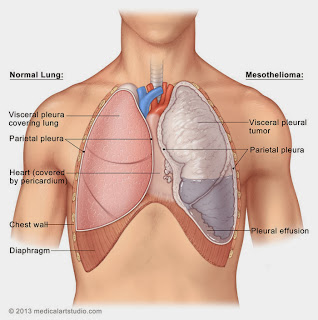Mesothelioma And Pulmonary Decortication
Mesothelioma And Pulmonary DecorticationAnother interesting study is called, “Pleurectomy for mesothelioma.” By Brancatisano RP, Joseph MG, McCaughan BC - Department of Surgery, Repatriation General Hospital Concord, NSW. Med J Aust. 1991 Apr 1;154(7):455-7, 460. Here is an excerpt: “Abstract - OBJECTIVE: To assess the effectiveness and safety of parietal pleurectomy in establishing a tissue diagnosis and controlling pleural fluid accumulation in patients with pleural mesothelioma, and to assess the success of this procedure in effecting palliation.
DESIGN AND SETTING: Fifty consecutive patients with pleural mesothelioma who underwent thoracotomy at the cardiothoracic units at Concord and Royal Prince Alfred Hospital were reviewed retrospectively. The male:female ratio was 4:1 and the mean age was 63 years. In only 11 of the 50 patients was a tissue diagnosis of mesothelioma made before surgery. INTERVENTIONS: At thoracotomy, subtotal parietal pleurectomy was performed in 45 of the 50 patients. In two patients biopsy alone was performed and three patients were treated by a chemical pleurodesis only, as pleurectomy was not technically possible. Pulmonary decortication was required in 28 patients to allow full expansion of the underlying lung for effective pleurodesis.
RESULTS: There was one postoperative death. The morbidity rate was 16%. Excluding the patient who died in the postoperative period, the median survival was 16 months, and ranged from three to 54 months, with 21% of patients surviving for more than two years. Only one patient developed a reaccumulation of pleural fluid.
CONCLUSIONS: Pleurectomy, with decortication when required, provides both a tissue diagnosis and effective control of pleural fluid accumulation and therefore excellent palliation in patients with pleural mesothelioma. We advocate early thoracotomy in these patients.”
Another interesting study is called, “Use of a “Replication-Restricted” Herpes Virus to Treat Experimental Human Malignant Mesothelioma” by John C. Kucharczuk1, Bruce Randazzo1, Michael Y. Chang, Kunjlata M. Amin, Ashraf A. Elshami, Daniel H. Sterman, Nabil P. Rizk, Katherine L. Molnar-Kimber, S. Moira Brown, Alasdair R. MacLean, Leslie A. Litzky, Nigel W. Fraser, Steven M. Albelda, and Larry R. Kaiser – Cancer Res February 1, 1997 57; 466 - Here is an excerpt: “Abstract - Modified, nonneurovirulent herpes simplex viruses (HSVs) have shown promise in the treatment of brain tumors.
However, HSV-1 can infect and lyse a wide range of cell types. In this report, we show that HSV-1716, a mutant lacking both copies of the gene coding ICP-34.5, can effectively treat a localized i.p. malignancy. Human malignant mesothelioma cells supported the growth of HSV-1716 and were efficiently lysed in vitro. i.p. injection of HSV-1716 into animals with established tumor nodules reduced tumor burden and significantly prolonged survival in an animal model of non-central nervous system-localized human malignancy without dissemination or persistence after i.p. injection into SCID mice bearing human tumors. These findings suggest that this virus may be efficacious and safe for use in localized human malignancies of nonneuronal origin such as malignant mesothelioma.
An interesting study is called, “Interleukin 6 and its relationship to clinical parameters in patients with malignant pleural mesothelioma.” By T. Nakano, A. P. Chahinian, M. Shinjo, A. Tonomura, M. Miyake, N. Togawa, K. Ninomiya, and K. Higashino - Br J Cancer. 1998 March; 77(6): 907–912. Here is an excerpt: “Abstract - The relationship between interleukin 6 (IL-6) levels and clinical parameters was studied in 25 patients with malignant pleural mesothelioma. The serum levels of IL-6, C-reactive protein, alpha1-acid glycoprotein and fibrinogen were significantly higher in mesothelioma than in lung adenocarcinoma with cytology-positive pleural effusion. Serum IL-6 levels correlated with the levels of the acute-phase proteins. We demonstrated a high incidence of thrombocytosis (48%) and a significant correlation between platelet count and the serum IL-6 level.
An interesting study is called, “Interleukin 6 and its relationship to clinical parameters in patients with malignant pleural mesothelioma.” By T. Nakano, A. P. Chahinian, M. Shinjo, A. Tonomura, M. Miyake, N. Togawa, K. Ninomiya, and K. Higashino - Br J Cancer. 1998 March; 77(6): 907–912. Here is an excerpt: “Abstract - The relationship between interleukin 6 (IL-6) levels and clinical parameters was studied in 25 patients with malignant pleural mesothelioma. The serum levels of IL-6, C-reactive protein, alpha1-acid glycoprotein and fibrinogen were significantly higher in mesothelioma than in lung adenocarcinoma with cytology-positive pleural effusion. Serum IL-6 levels correlated with the levels of the acute-phase proteins. We demonstrated a high incidence of thrombocytosis (48%) and a significant correlation between platelet count and the serum IL-6 level.
The level of IL-6 in the pleural fluid of patients with mesothelioma was significantly higher than in the pleural fluid of patients with adenocarcinoma, and was about 60-1400 times higher than in the serum. However, even higher levels of IL-6 in the pleural fluid and of thrombocytosis were found in patients with tuberculous pleurisy. These results indicate that large amounts of IL-6 from the pleural fluid of patients with mesothelioma leak into the systemic circulation and induce clinical inflammatory reactions. These profiles are not specific to mesothelioma as similar profiles are found in patients with tuberculous pleurisy. However, the detection of a markedly increased level of IL-6 in pleural fluid argues against a diagnosis of adenocarcinoma.”
We all owe a debt of gratitude to these fine researchers for their work. If you found any of these excerpts helpful, please read the studies in their entirety.
We all owe a debt of gratitude to these fine researchers for their work. If you found any of these excerpts helpful, please read the studies in their entirety.






0 comments: